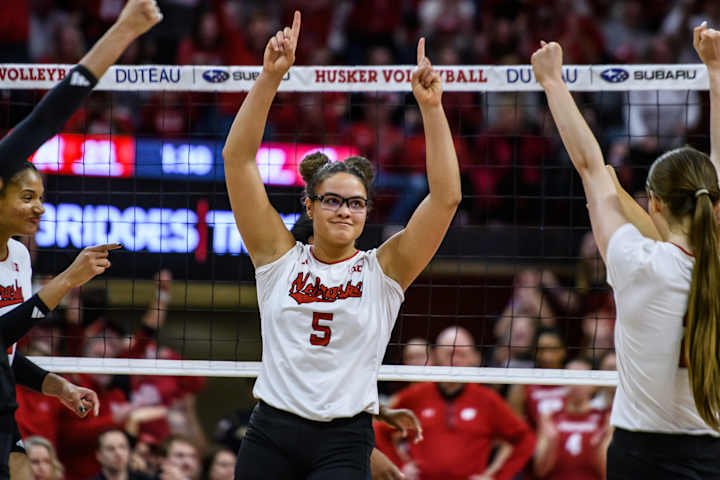It started like any other evening in Lincoln, Nebraska. The sky was streaked in shades of gold, the smell of summer still hanging in the air as thousands poured into Memorial Stadium—not for football this time, but for something no one saw coming: a record-breaking women’s volleyball match that would flip the script on what sports, community, and history could look like.
They called it volleyball Day in Nebraska. But what it became was Volleyball’s Day in History.
Over 92,000 people—yes, that’s ninety-two thousand—crammed into a football stadium to watch the University of Nebraska’s women’s volleyball team take on the University of Nebraska at Omaha. That made it the largest crowd to ever attend a women’s sporting event in the entire history of Earth. The roar was deafening. The energy? Nuclear. The impact? Generation-defining.
Every inch of the stadium pulsated with chants, pride, and the kind of emotion that you don’t just hear—you feel in your bones. This wasn’t just about volleyball. This was about rewriting narratives. A Midwest town once underestimated was now commanding the global sports spotlight, powered not by dollars, but by devotion.
PART 2: A RALLY FOR MORE THAN A GAME
For decades, Nebraska had been quietly building a volleyball dynasty—one of discipline, unity, and quiet domination. Coach John Cook, the architect behind Nebraska Volleyball’s rise, wasn’t the kind of leader who shouted from the rooftops. Instead, he built belief in gymnasiums, one serve, one dig, one sacrifice at a time.
But August 30th, 2023, was different. It wasn’t just about plays or points. It was about presence. About daring to believe that women’s sports could fill stadiums not out of novelty, but out of necessity.
Lexi Rodriguez, Nebraska’s libero and defensive powerhouse, said it best during the press tour leading up to the game:
“We’ve always had the heart. Now we’re giving the world a chance to see it beat louder than ever.”
And beat it did.
From farmers to high schoolers, parents to military vets, generations of Nebraskans piled into Memorial Stadium draped in red and white. The match itself? A display of surgical skill and raw athletic beauty. Powerful spikes echoed like firecrackers. Impossible saves drew gasps loud enough to rival a Fourth of July finale. But beyond the scoreboard, something transcendent was happening. Every rally became a declaration. Every cheer, a revolution.
Part 3: WHEN ONE NIGHT ECHOED AROUND THE WORLD
The final whistle had barely pierced the night sky before the numbers hit the newswires: 92,003 people. The largest audience ever recorded for a women’s sports event—anywhere.
Bigger than the 1999 FIFA Women’s World Cup Final. Bigger than Serena at Centre Court. This volleyball match, born from the dusty prairies of the American Midwest, had outgrown its roots and shot straight into legend.
Social media didn’t just light up—it combusted. Hashtags trended globally: #NebraskaStrong, #VolleyHistory. Global news outlets scrambled to cover the spectacle. Sports legends from across disciplines tweeted praise. Girls from Tokyo to Lagos posted videos reenacting their favorite plays, dreaming in red jerseys and knee pads.
And at the heart of it all? A sisterhood of athletes who didn’t just play to win—they played to belong, to beseen, and to show the next generation that power is possible in every position.
Coach Cook stood with misty eyes during the post-match interview. He didn’t shout. He didn’t bask. He just said:
“This crowd isn’t here because we asked. They’re here because they’ve always believed in us—even when the world didn’t.”
It wasn’t just a game. It was a seed, and something big had begun to bloom.
Part 4: A Legacy Lit in Stadium Lights
As the final point soared over the net and found the floor, the crowd erupted—not just for a win, but for a moment that felt bigger than the court, the scoreboard, or the sport itself.
That night, young girls didn’t just witness a volleyball match. They saw themselves in the spotlight. They saw athletes who weren’t background extras to men’s games—they were the main event. Confident, fast, fierce. They didn’t apologize for taking up space. They filled it.
Across the state, school gyms reported surges in volleyball sign-ups. Ticket sales to women’s college games skyrocketed. Entire school districts hosted watch parties to replay the match. ESPN called it “the night volleyball became the national pastime—if only for a blink.”
And inside Memorial Stadium, the lights glowed long after the players exited. Not a soul left quickly. Families lingered. Students stood in the aisles dazed. Elderly couples hugged. Strangers became teammates in celebration.
This wasn’t a moment that would fade with the news cycle. It was the start of a seismic shift—the kind that cracks old ceilings and builds new arenas atop the rubble.
The question wasn’t whether this could happen again.
The only question left was: where next?
Part 5: When Dreams Take Flight
The record books captured the numbers, but hearts captured the meaning. Because at its core, this wasn’t just about volleyball. It was about what happens when people dare to dream big enough to shake the ground they stand on.
Every girl who watched that match saw something priceless: permission. Permission to aim higher. To jump farther. To imagine herself not just participating in history—but *making* it.
Volleyball Day in Nebraska didn’t just raise a net; it raised the bar. For how we support women’s sports. For how stories are told. For how communities rise when they rally around purpose, not profit.
Long after the stadium lights dimmed, the glow remained—in every highlight reel replayed, in every young athlete tying her laces tighter, in every coach who now knows what’s possible when belief meets opportunity.
It wasn’t just one game. It was a reminder: sometimes, to change the world, all you need is a ball, a dream, and a crowd willing to believe.
And if 92,003 people in a Midwestern stadium can do that?
Then maybe—just maybe—we’re all standing one cheer away from greatness.

